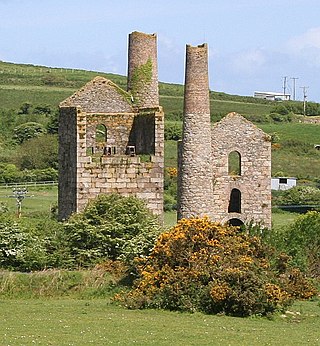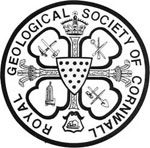The School of Metalliferous Mining was formed in 1910 by the amalgamation of all the mining schools in Cornwall, England. [1]
In the 19th century mining schools under government patronage were being established all across the British Empire. There were at the time three mining schools in Cornwall; at Camborne, Penzance and Redruth and it was felt that they should be combined. The newly amalgamated school would occupy the Camborne Mining School site and the Camborne Mining School brand be continued. Mr. W. Ficher Wilkinson was appointed as the first principal of the newly formed School of Metalliferous Mining. He was educated at Harrow and at the Freiberg University of Mining and Technology in Germany.
The school later included Camborne in the title creating the Camborne School Of Metalliferous Mining, and in 1975 the school changed its name to Camborne School of Mines to better describe its academic activities.
The Redruth School of Mines and Art School opened in 1882 or 83 and was located somewhere in Clinton Road to the east of the town. With the removal of mining education to Camborne the site became the Science and Art School and continued to teach art and science.
A wing of the Redruth Mining School was a large mineral museum called the Robert Hunt Memorial Museum erected by The Miners Association of Devon and Cornwall to the memory of Robert Hunt FRS, keeper of the Mining Record Office in London. This museum remained open until 1950 when it closed and the specimens were taken to the Camborne School of Mines.
The Camborne campus of Camborne School of Mines, as it became known, was located just off Camborne Trelowarren Street in Trevu Road. In 1876 George Basset, the great mine entrepreneur, made a bequest to build a laboratory in Camborne, The Basset Building, for the use of the pupils of The Miners Association. In 1882 the adjacent Camborne Science and Art School building opened. Until the amalgamation of the schools in 1910 Mr. J.J. Beringer had been principal for 28 years.
The Penzance Mining and Science School opened on 7 October 1890, at a cost for building and fittings of nearly £1,900. The school consisted of two floors, the ground floor housed the technical instruction hall and the lecture theatre and upstairs chemical lecture rooms, class rooms and a laboratory filled with working benches for 24 students, a furnace room for metallurgical work and a balance room. Andrew Ketcham Barnett was the first principal of the Mining and Science School at Penzance, which had been established due to his classes on mineralogy in 1873. Philip Burne Corin (1860-1933) was a master here from 1893 to 1910.

Redruth is a town and civil parish in Cornwall, England, United Kingdom. The population of Redruth was 14,018 at the 2011 census. In the same year the population of the Camborne-Redruth urban area, which also includes Carn Brea, Illogan and several satellite villages, stood at 55,400 making it the largest conurbation in Cornwall. Redruth lies approximately at the junction of the A393 and A3047 roads, on the route of the old London to Land's End trunk road, and is approximately 9 miles (14 km) west of Truro, 12 miles (19 km) east of St Ives, 18 miles (29 km) north east of Penzance and 11 miles (18 km) north west of Falmouth. Camborne and Redruth together form the largest urban area in Cornwall and before local government reorganisation were an urban district.

Camborne is a town in Cornwall, England, United Kingdom. The population at the 2011 Census was 20,845. The northern edge of the parish includes a section of the South West Coast Path, Hell's Mouth and Deadman's Cove.

Camborne School of Mines, commonly abbreviated to CSM, was founded in 1888. Its research and teaching is related to the understanding and management of the Earth's natural processes, resources and the environment. It has undergraduate, postgraduate and research degree programmes within the Earth resources, civil engineering and environmental sectors. CSM is located at the Penryn Campus, near Falmouth, Cornwall, UK. The school merged with the University of Exeter in 1993.

The King Edward Mine at Camborne, Cornwall, in the United Kingdom is a mine wholly owned by Cornwall Council.
The Miners Association was founded in 1858 by Robert Hunt FRS, and the Royal Cornwall Polytechnic Society. The Association was formed to create a body that would discuss, develop, address the needs and represent the hard rock mining industry within the south west region of the United Kingdom.

Mining in Cornwall and Devon, in the southwest of Britain, is thought to have begun in the early-middle Bronze Age with the exploitation of cassiterite. Tin, and later copper, were the most commonly extracted metals. Some tin mining continued long after the mining of other metals had become unprofitable, but ended in the late 20th century. In 2021, it was announced that a new mine was extracting battery-grade lithium carbonate, more than 20 years after the closure of the last South Crofty tin mine in Cornwall in 1998.

The Royal Cornwall Polytechnic Society is an educational, cultural and scientific charity, as well as a local arts and cinema venue, based in Falmouth, Cornwall, England, United Kingdom. The Society exists to promote innovation in the arts and sciences.

Gwennap is a village and civil parish in Cornwall, England, United Kingdom. It is about five miles (8 km) southeast of Redruth. Hamlets of Burncoose, Comford, Coombe, Crofthandy, Cusgarne, Fernsplatt, Frogpool, Hick's Mill, Tresamble and United Downs lie in the parish, as does Little Beside country house.

Mineral del Monte, commonly called Real del Monte or El Real, is a small mining town, and one of the 84 municipalities of Hidalgo, in the State of Hidalgo in east-central Mexico.

Robert Hunt was a British mineralogist, as well as an antiquarian, an amateur poet, and an early pioneer of photography. He was born at Devonport, Plymouth and died in London on 17 October 1887.

Dolcoath mine was a copper and tin mine in Camborne, Cornwall, United Kingdom. Its name derives from the Cornish for 'Old Ground', and it was also affectionately known as The Queen of Cornish Mines. The site is north-west of Carn Brea. Dolcoath Road runs between the A3047 road and Chapel Hill. The site is south of this road.

Pool is a village in Carn Brea civil parish in west Cornwall, England. It is bypassed by the A30, on the A3047 between Camborne and Redruth, between Tuckingmill and Illogan Highway.

Tuckingmill is a village in Cornwall, England, United Kingdom, which is in the civil parish of Camborne. Tucking Mill was the Cornish term for a fulling mill which was where homespun cloth was dipped, cleansed and dressed. There is a mention of a fulling mill in this region as early as 1250. The ecclesiastical parish of Tuckingmill was constituted in 1845, being carved out of a western section of the parish of Illogan and an eastern section of Camborne parish. It covers 1,300 acres (5.3 km2).

The Camborne Redruth Community Hospital is a National Health Service hospital in Cornwall, England. It is managed by Cornwall Partnership NHS Foundation Trust.

The Royal Geological Society of Cornwall is a geological society originally based in Penzance, Cornwall in the United Kingdom. It was founded in 1814 to promote the study of the geology of Cornwall, and is the second oldest geological society in the world, after the Geological Society of London which was founded in 1807.

Wheal Gorland was a metalliferous mine located just to the north-east of the village of St Day, Cornwall, in England, United Kingdom. It was one of the most important Cornish mines of the late 18th and early 19th centuries, both for the quantity of ore it produced and for the wide variety of uncommon secondary copper minerals found there as a result of supergene enrichment. It is the type locality for the minerals chenevixite, clinoclase, cornwallite, kernowite and liroconite.

East Pool mine, was a metalliferous mine in the Camborne and Redruth mining area, just east of the village of Pool in Cornwall. Worked from the early 18th century until 1945, first for copper and later tin, it was very profitable for much of its life. Today the site has two preserved beam engines and is part of the Cornwall and West Devon Mining Landscape World Heritage Site. It is owned by the National Trust.

The Trevithick Society is a registered charity named for Richard Trevithick, a Cornish engineer who contributed to the use of high pressure steam engines for transportation and mining applications.

Basset Mines was a mining company formed in Cornwall, England, by the amalgamation of six copper and tin mining setts. It operated from 1896 until 1918, when it was closed due to a fall in the price of tin.
Presented below is an alphabetical index of articles related to Cornwall: